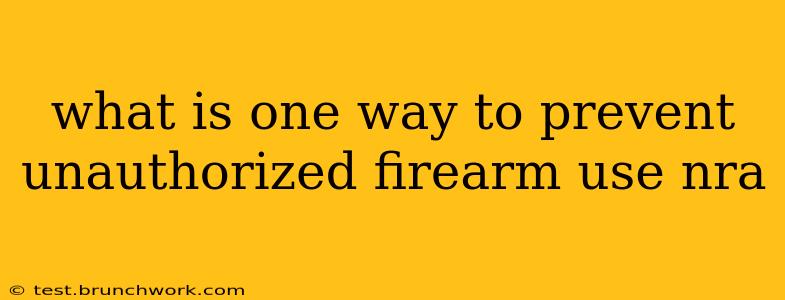The unauthorized use of firearms is a serious concern, demanding a multifaceted approach to prevention. While there's no single solution, responsible gun ownership stands out as a crucial element in minimizing this risk. This isn't just about adhering to the letter of the law; it's about cultivating a culture of safety and accountability around firearms.
The Foundation: Secure Storage
Perhaps the most effective preventative measure is secure firearm storage. This goes beyond simply locking a gun in a cabinet; it requires diligent attention to detail and a proactive approach to security. Consider these aspects:
- Safe Selection: Invest in a high-quality gun safe that meets or exceeds industry standards. Look for features like fire resistance and tamper-proof mechanisms. A simple gun lock isn't sufficient for long-term security.
- Location, Location, Location: Store the safe in a discreet, inaccessible location, ideally out of the reach of children and unauthorized individuals. Avoid easy-to-guess hiding spots.
- Ammunition Storage: Separate ammunition storage is equally vital. Keeping ammunition and firearms apart significantly reduces the risk of accidental or unauthorized access. Consider using a separate, similarly secure container for your ammunition.
- Regular Checks: Periodically inspect your safe and its contents to ensure everything is secure. This proactive approach identifies potential problems before they become security breaches.
Beyond the Safe: Education and Training
Secure storage is only part of the equation. Responsible gun ownership also necessitates comprehensive education and training:
- Firearm Safety Courses: Taking a certified firearms safety course is paramount. These courses teach proper handling, storage, and safe practices, reducing the likelihood of accidental discharge or misuse.
- Safe Handling Practices: Always treat every firearm as if it were loaded. Never point a gun at anything you don't intend to shoot. Keep your finger off the trigger until you are ready to fire. These basic rules are fundamental to preventing accidents.
- Child Safety Measures: If children are present in the home, gun safety education is crucial. Teach children about the dangers of firearms and the importance of never touching them without adult supervision. Consider installing gun locks that require a key or combination, further preventing unauthorized access by children.
- Ongoing Learning: The landscape of firearm safety is constantly evolving. Stay informed about the latest safety practices and technologies through continuous learning and engagement with reputable resources.
Community and Communication
Responsible gun ownership extends beyond individual actions; it encompasses a sense of community responsibility:
- Open Communication: Talk to family members and housemates about firearm safety. Ensure everyone understands the importance of secure storage and safe handling practices.
- Reporting Concerns: If you suspect someone is misusing a firearm or storing it improperly, report your concerns to the appropriate authorities. This could prevent potential harm to the individual or the community.
By focusing on secure storage, comprehensive training, and open communication, we can significantly reduce the risk of unauthorized firearm use. This approach isn't about restricting access; it's about promoting responsible behavior and fostering a culture of safety that protects everyone. This collective effort is vital in creating safer communities.
